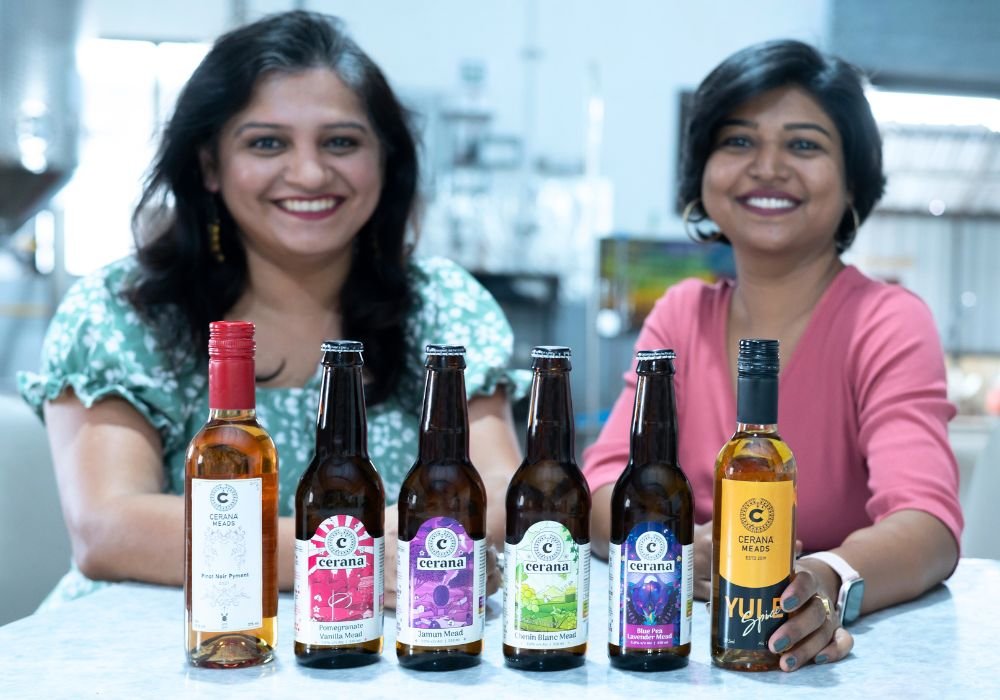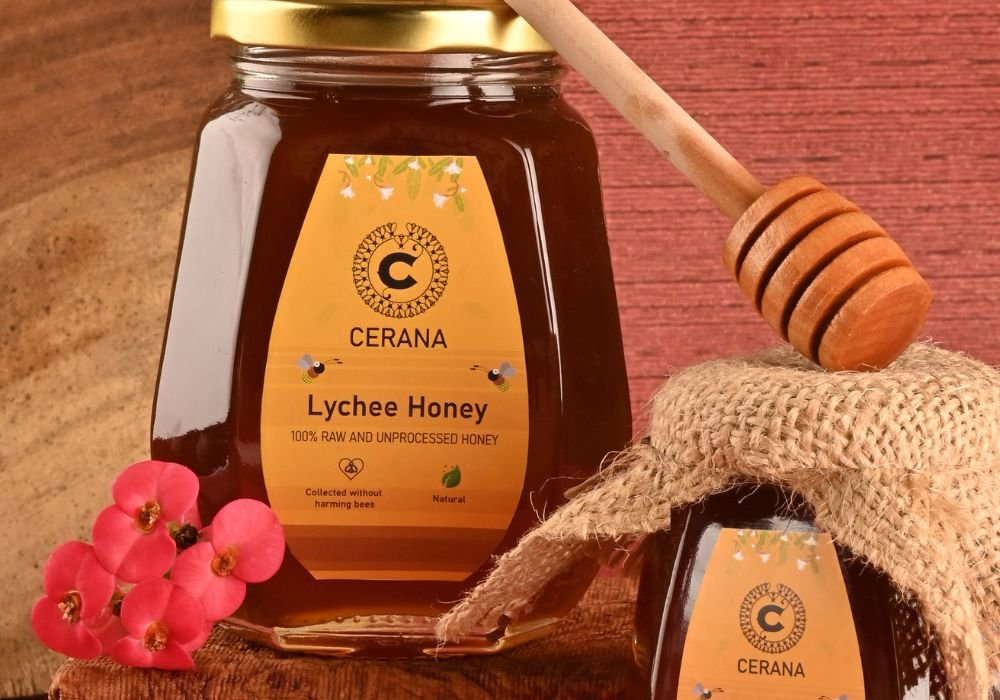
As the world of craft beverages continues to expand, mead, often hailed as the "nectar of the gods," is finding its way back into the glasses of enthusiasts and curious drinkers alike. In recent years, mead has experienced a resurgence in popularity, with craft meaderies producing innovative and unique variations, contributing to the growth of the mead market in various regions.
Join the founders of Cerana Meads in their dedication to revitalizing mead-making, preserving tradition, and offering a diverse range of flavors that captivate the senses. As Cerana Meads continues to make waves in the beverage industry, discover how its identity, blending tradition, innovation, and a green mindset, resonates with consumers seeking authentic and eco-conscious choices in the world of craft beverages.
Learn about the brand's commitment to sustainability and eco-conscious practices, from ethically sourced honey to the "farm-to-bottle" philosophy. With a focus on environmental responsibility, Cerana Meads aims to revolutionize the ancient drink of mead while leaving a positive impact on the planet. Explore the brand's expansion plans, the reception of meads in different regions, and the unique features of limited-edition seasonal meads like Yule Spice and Pinot Noir Pyment.
Could you share the inspiration and journey behind the founding of Cerana Meads, especially considering its roots in Nashik's Sinnar region?
Ashwini and I discovered about meads through a British professor who visited our department while we were pursuing our doctorates at the Food Engineering and Technology Department, ICT, Mumbai. When he introduced us to mead, an alcoholic beverage made by fermenting honey, we were both intrigued by the idea. I was already fascinated by honey bees and all they do for us through their mere presence. Alcohol had always been an area of interest for both Ashwini and me, and fermenting honey into alcohol seemed to tick all the boxes of our interests: bees, honey, something with a rich history, a promising future, as well as the scope for innovation, never leaving sustainability aside.
First, I started making meads as a hobby, exploring different honeys, and then Ashwini joined me when we decided to turn it into a business. We experimented with various honey and their combinations with different fruits and spices, creating a basic database of information, as none was available at the time on Indian honey fermentation. Then, recipes took shape, and their commercial viability was tested before finalizing a few for the brand.
Choosing Nashik for the meadery came with several natural reasons. Nashik is the wine capital of the country, attracting a lot of wine tourism. Additionally, Nashik is Ashwini's hometown. She grew up here, and her family is here. So, it was a no-brainer to select Nashik for setting up the meadery.

How do you emphasise Indian flavours in Cerana Meads, and what role do locally sourced ingredients like jamuns, pomegranates, and grapes play in your meads?
There are many fruits and agricultural produce that, on their own, cannot be fermented into wines. However, when combined with honeys, we can easily include them in the alcobev segment. Our focus was to find and use such ingredients in our meads while keeping them exciting for the end consumer.
At Cerana, we emphasize Indian flavors by sourcing our ingredients as locally as possible. We are committed to a "farm-to-bottle" philosophy, ensuring premium, ethically sourced, all-natural ingredients. Our honey varieties, such as mustard honey from Rajasthan and litchi honey from Bihar, contribute unique regional characteristics. We have also launched the first in our floral series of meads: the Blue pea Lavender Mead, which uses dried blue pea and lavender flowers infused in fermented mustard honey.
Can you tell us about the unique characteristics and profiles of your meads, such as the Pomegranate Melomel, Jamun Melomel, and Chenin Blanc Pyment?
Our commitment to creating unique and unforgettable experiences is reflected in the distinct characteristics of our meads. Our Jamun mead is a delightful infusion of Jamun fruit from Konkan with Jamun honey from Madhya Pradesh. The combination of Jamun and citrus notes enhances the earthy concoction, offering a light and crisp profile. As you savour this mead, you'll experience a multi-layered fruity tang with mild tartness, culminating in the unmistakable taste of Jamun that leaves a dry finish.
The Pomegranate Melomel, on the other hand, is a captivating blend of pomegranates sourced from Nashik, giving it a pretty pink color when poured. Crafted with lychee honey from Bihar, this melomel boasts a distinct fruity, caramel, and vanilla aroma. On the palate, it unfolds with toffee and tart pomegranate upfront, followed by enchanting vanilla swirls. The finish is off-dry, leaving lingering fruity notes that remind of a refreshing tropical punch.
Our Chenin Blanc Pyment is an innovative creation, featuring the most popular grapes from India's wine capital, Nashik. This pyment is made with chenin blanc grapes, known for their herbaceous flavour and citric acidity. The grapes harmonize wonderfully with multifloral honey from Himachal Pradesh, bringing out spicy notes of cinnamon, lemons, and bay leaf. The result is a pyment that stands out for its unique combination of grape and honey characteristics. (FYI: Melomel is a type of mead with added fruits, in this case, pomegranates. Pyment is a mead that incorporates grape juice, and here, it features chenin blanc grapes.)
The limited-edition seasonal meads, like Yule Spice and Pinot Noir Pyment, sound intriguing. What can you share about these varieties, including their unique flavours and higher alcohol content?
Yule Spice Mead is our seasonal mead, whereas Pinot Noir Pyment is available all year round. Lately, considering the positive response, we have decided to keep Yule Spice available throughout the year as well. Yule Spice is our festive mead, offering unique flavours. Aged in French Oak, it features warm aromas of cinnamon and ginger, along with sweet, earthy Jamun honey notes—perfect for the winter season. Additionally, it serves as an excellent base for mulled mead, adding a festive vibe to your winters.
With Cerana Meads being available in Mumbai, Nashik, and Pune, how do you see the reception of meads in different regions, and are there plans for expansion?
We have received positive feedback for our products during initial tastings and garnered a lot of interest from various markets. We are looking to expand our presence to other states soon, with contenders for expansion in the next financial year being Delhi and Goa.
In what ways is Cerana Meads revitalising the ancient drink of mead, and how do you approach infusing it with a modern twist to cater to both traditional and contemporary palates?
We've maintained a natural process in crafting our meads. We simply mix the ingredients and let nature work its magic, intervening minimally with day-to-day monitoring to ensure the fermentation is on the right track. Our primary intervention isn't in the recipe but in quality control to guarantee only the best mead gets bottled. This approach allows us to harness the best of both worlds—utilizing a natural process monitored with modern techniques, resulting in truly craft meads.
From a technical perspective, our production team enjoys the freedom to experiment with various ingredients. Ashwini and I are always on an e-foraging mission, constantly seeking different honeys and agricultural produce to be innovatively incorporated into our meads. This effort enables us to create recipes that capture the hearts of the market.
Speaking of innovation, let me again highlight our Blue pea Lavender Mead. This mead is not only a treat for the nose and tongue but, thanks to the vibrant blue hues of the blue pea flower, it's also a feast for the eyes. Currently, we have our next floral mead in the R&D phase. It comes with an exciting recipe, and we're optimistic that it will be well-received by the market.

Cerana Meads is committed to environmental responsibility. How does the brand integrate sustainable beekeeping practices, and in what ways does this commitment shape your overall operations?
Honey bees naturally store the honey they use for their own sustenance in the lower two-thirds part of the honeycomb, while the surplus honey is stored in the top one-third part of the comb. In the structure of a beebox, these two parts are built in such a way that they can be physically separated; the upper part is called a super chamber or a honey chamber, while the lower part is called a brood chamber. The queen bee lays eggs in the cells of this chamber. This structure ensures that we don't disturb the day-to-day activities of the bees while harvesting the honey from the super chamber.
In addition to this, honey bees ensure that the stored honey has the maximum shelf life by reducing the moisture content to the minimum possible through fanning the stored honey. Once the minimum moisture is achieved, they seal the cell with wax, indicating 100% completely natural formation of honey. We only procure honey harvested from the super chamber and sealed comb. We take pride in not stealing honey from the bees.
Similar to honey, we ensure that the other ingredients used in our meads also come from farms that follow sustainable practices. By using these ingredients, we have already achieved our green goals. For every pint of Cerana Mead consumed, we have ensured the cross-pollination of 40 lakh flowers. We are working towards saving the earth, one pint at a time.

From classic meads to creative blends, Cerana Meads offers a diverse range of flavours. What inspires the creation of these unique blends, and how do you ensure a memorable mead-drinking experience?
Our commitment to providing a diverse range of flavours stems from a passion for innovation and a deep appreciation for the art of mead-making. The inspiration for our unique blends comes from a variety of sources. We draw inspiration from traditional meads, exploring classic recipes and techniques. Our team finds creative inspiration in the ever-evolving world of culinary arts, seeking out exciting combinations of fruits, spices, and honeys.
To ensure a memorable mead-drinking experience, we focus on a few key principles. Quality is paramount. We source the finest ingredients, emphasizing local flavours to create a connection with our community and the environment. Our production team enjoys the freedom to experiment with different ingredients, allowing us to push the boundaries of traditional mead-making.
Moreover, our dedication to a natural process, as well as our blend of old-fashioned techniques with modern monitoring methods, contributes to the unique character of each mead. We carefully monitor the fermentation process to guarantee a high-quality end product.
The joy of crafting meads that captivate the senses and leave a lasting impression is at the core of what we do. From the aroma to the taste, we aim to create an experience that resonates with mead enthusiasts and newcomers alike. Our constant exploration and commitment to excellence ensure that every sip of Cerana Mead is not just a beverage but a journey through diverse and unforgettable flavours.
Can you delve into the stories and inspirations behind some of Cerana Meads' signature creations, shedding light on what makes them stand out?
This question is challenging for both Ashwini and me, as it's akin to asking a parent to choose their favourite child. Nevertheless, I will attempt to answer. Every mead we create stands on its own, with a unique flavour profile and tasting notes. At this point, I'd like to highlight Yule Spice, which holds a special place for various reasons. It is the first high-strength mead we launched and the initial honey-forward mead we crafted. Moreover, it will soon be the first mead to venture beyond Indian borders and enter international markets.
During my early days of crafting meads as a hobby, I created a rudimentary recipe for Yule Spice. Ashwini, with her flair for flavours and cooking, perfected this gem for all of us. The second mead I want to discuss is the Jamun Mead. I must admit, it's not for everyone, but it holds a special place in both our hearts. Ashwini crafted this mead especially for me when she took a few months off as a new mom to care for her son, now eight years old. Despite not being thrilled about being away from Cerana for an extended period, she created a mead she thought I would enjoy, and indeed, I love it! Every sip is like the monsoon, and every whiff is reminiscent of summer. This robust mead invokes memories of the start of school in June, coinciding with the fruit's availability. It takes us back to the days of new backpacks, new uniforms, new books with fresh covers, and the excitement of everything new.
While we have strong emotional connections to these two meads, I must emphasize that we cherish all our meads equally.
How would you describe the identity of Cerana Meads, considering its representation of tradition, innovation, and a green mindset? How do these elements resonate with consumers seeking authentic and eco-conscious beverage choices?
I believe the identity of Cerana is a perfect blend of tradition, innovation, and sustainability. We cherish traditional mead-making practices, infusing them with a modern twist to create a unique experience. Our commitment to sustainability is evident in every step, from sourcing to production, ensuring our practices are eco-friendly.
These elements resonate with consumers seeking authentic and eco-conscious beverage choices. Our green mindset, reflected in sustainable practices, appeals to environmentally conscious consumers who seek not just a drink but a meaningful choice in every bottle of Cerana Meads.













